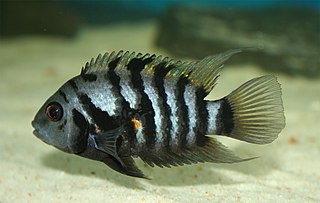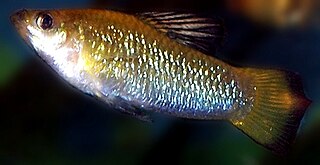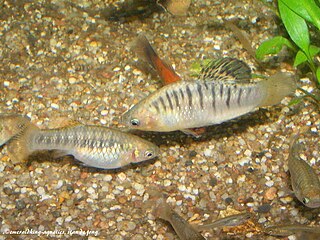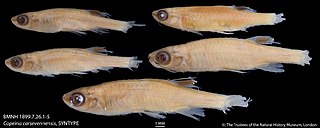
The black ruby barb or purplehead barb is a tropical cyprinid fish endemic to Sri Lanka, where it occurs in forested streams from the Kelani basin to the Nilwala basin. They are found in streams on hills around 1000 ft in elevation. The brightly colored population introduced to Mahaweli at Ginigathena, Sri Lanka, is said to have diminished in number due to the aquarium export trade.

The convict cichlid is a fish species from the family Cichlidae, native to Central America, also known as the zebra cichlid. Convict cichlids are popular aquarium fish and have also been the subject of numerous studies on fish behaviour.

Copella is a genus of freshwater fish belonging to the family Lebiasinidae, native to South America, known colloquially to aquarists as splashing tetras or splash tetras, because of the unique reproductive method of the best-known representative of the genus, Copella arnoldi. They are not as closely related to the tetras proper in the Characidae as initially believed.

Limia is a genus of livebearing fishes belonging to the Cyprinodontiform family Poeciliidae, which includes other livebearers such as platys, swordtails, guppies and mollies. They are found in fresh and brackish water. Of the 21 described Limia species, 17 are endemic to Hispaniola, one is found on both Hispaniola and Jamaica, and the Cayman Islands, Cuba, and Venezuela have an endemic species each. Limia are popular in aquaria among more advanced hobbyists.

The humpbacked limia or black-barred limia is a critically endangered species of poeciliid fish which is endemic to Haiti. Its common name is derived from the hump males develop as they age. It is sometimes kept in home aquaria.

Amatitlania is a genus of cichlid fishes native to freshwater habitats in Central America from El Salvador and Guatemala to Panama. They are fairly small cichlids, typically reaching up to 6.4–10 cm (2.5–4 in) in standard length depending on exact species, although captives may grow larger.

The blackbanded darter is a species of freshwater ray-finned fish, a darter from the subfamily Etheostomatinae, part of the family Percidae, which also contains the perches, ruffes and pikeperches. It is native to the river systems of the southeastern United States where it is found in the states of Tennessee, Georgia, Florida, Mississippi, Alabama, and Louisiana. It lives over sandy or gravelly bottoms in smaller rivers and streams and its color varies depending on the different habitats in which it lives. It feeds on small insect larvae and is itself preyed on by larger fish. It spawns between February and June depending on locality. It is generally a common fish throughout most of its range.

Pyrrhulina is a genus of freshwater fishes found in tropical South America. Several of these species are popular aquarium fish.

The black-banded trevally is a species of carangid native to the Indian Ocean, the western Pacific Ocean, and the Atlantic coast of southeastern South Africa. This species inhabits reefs and rocky bottoms at depths from 20 to 150 m. This species grows to 70 cm (28 in) in total length, and the maximum recorded weight reached is 5.2 kg (11 lb). It is of minor importance to local commercial fisheries, but is popular as a gamefish. This species is the only known member of its genus.
The blackstripe herring is a species of tropical sardine found in the Tropical Eastern Pacific, first documented in a coastal lagoon near Sonora, Mexico. Its diet consists of pelagic crustaceans, zooplankton, fish larvae, and fish eggs. It is typically found in muddy or sandy shores and high-salinity estuaries at depths of 0-10 meters.
The Puduari River is a river in the state of Amazonas, Brazil. It is a tributary of the Rio Negro.

Copella arnoldi, commonly known as the splash tetra or the splashing tetra, is a species of tropical freshwater fish belonging to the family Lebiasinidae. It is native to South America.
Copella vilmae is a species of fish in the splashing tetra family found in the upper Amazon basin. They grow no more than a few centimeters.

Copella carsevennensis is a species of fish in the splashing tetra family found in the upper Amazon basin, in the coastal tributaries and rivers of Amapá and The Guianas. They grow no more than a few centimeters in length and typically congregate near the surface of clear-water creeks and streams. They feed on mayfly larvae and ants. They spawn their eggs onto sunken leaves that the male guards.
Copella compta is a species of fish in the splashing tetra family found in the upper Rio Negro basin, as well as the Orinoco Basin. They grow no more than a few centimeters.
Copella eigenmanni is a species of fish in the splashing tetra family found along the Atlantic coast between Pará to Delta Amacuro, the mouth of the Orinoco. They grow no more than a few centimeters.
Copella meinkeni is a species of fish in the splashing tetra family found in the Amazon basin within Brazil and Venezuela. They grow no more than a few centimeters.
Copella metae is a species of fish in the splashing tetra family found in the upper Orinoco Basin and the upper Rio Negro basin. They grow no more than a few centimeters.
Copella nattereri or the spotted tetra is a species of fish in the splashing tetra family found in the upper Amazon basin, as well as the Rio Negro and Orinoco basins. They grow no more than a few centimeters.









